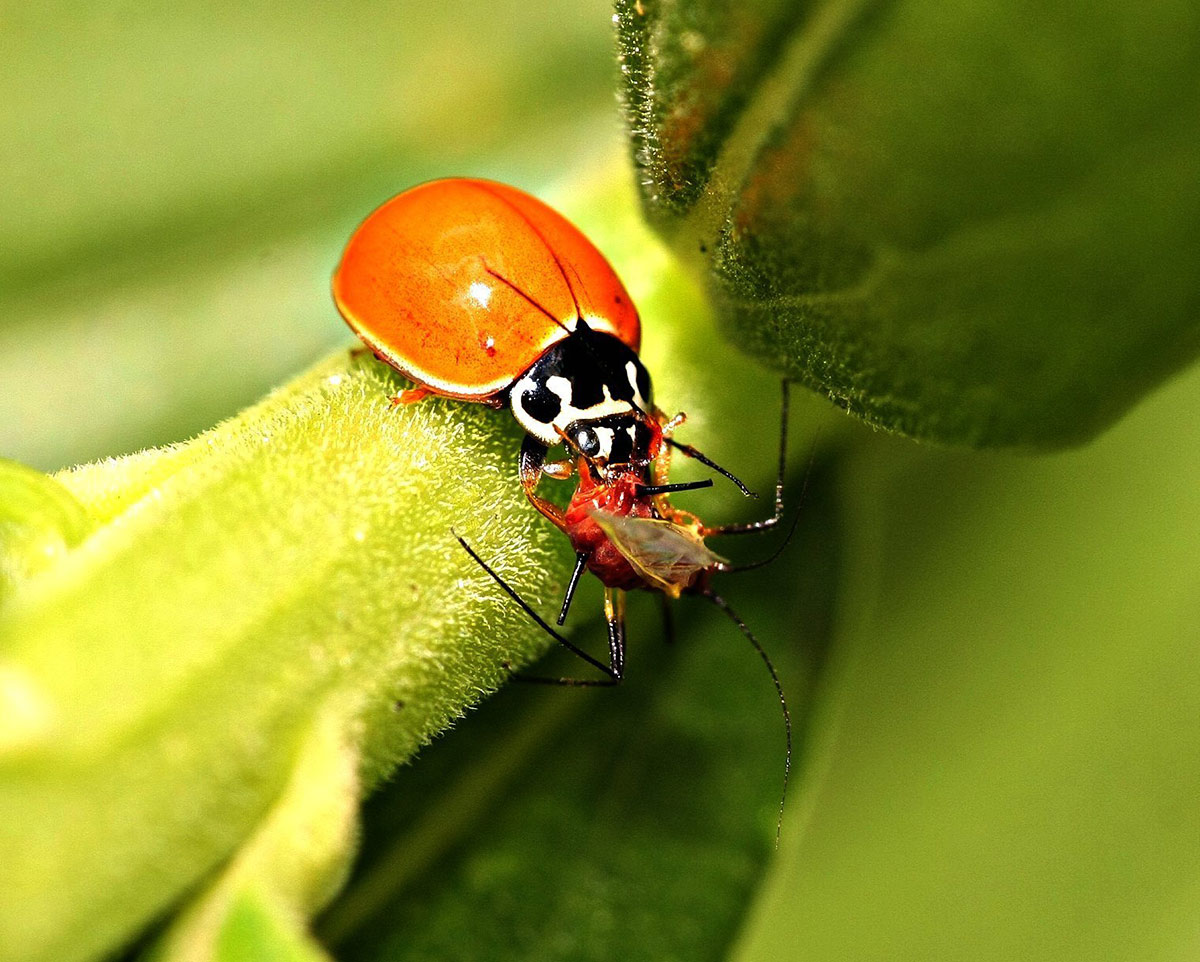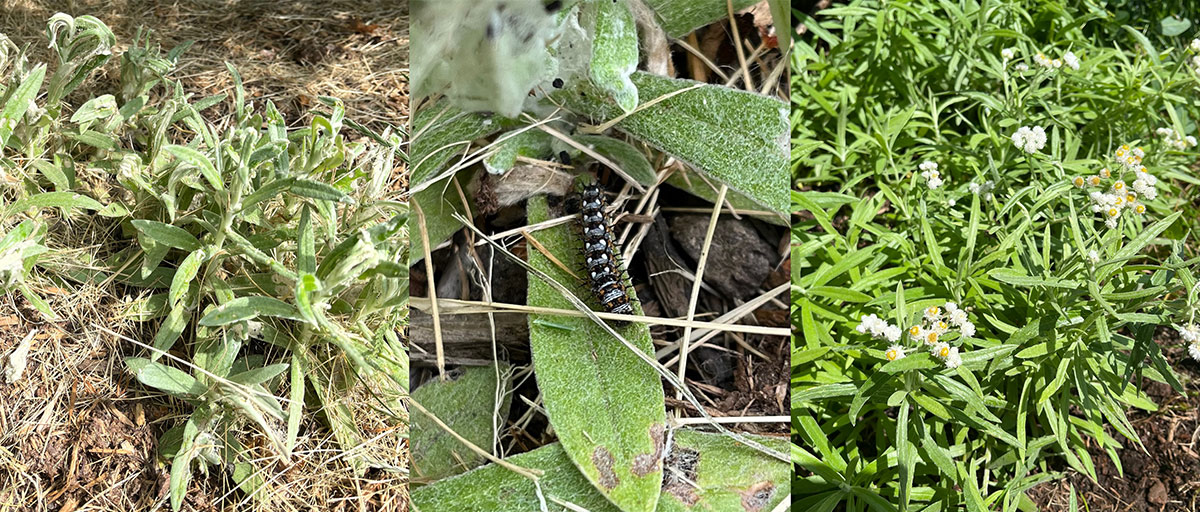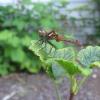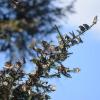Have you ever turned to advice from online gardening forums about damage on your garden plants? Chances are, you’ve encountered one of these eight common myths about pesticides in the garden. In this blog, we separate pesticide fact from fiction to help you take a pollinator-first approach to garden management.
1. "Pesticides only kill pests; they don't harm beneficial insects."
Reality: Most backyard pesticide treatments do not differentiate between harm to specific pests and harm to beneficial insects like ladybugs, bees, or other pollinators. One crucial example is the impact of pesticides in home gardens on caterpillars. Use of pesticides on or near butterfly host plants can reduce the population of caterpillars in the garden. Since they are a protein- and nutrient-rich food source for many bird species, this can lead to a decline in food for birds.
Pesticides can also disrupt the beneficial insects that help keep other garden pests in check. Spraying for mosquitoes, for instance, can harm insects like ladybugs, which naturally control aphids and scale insects. Loss of predatory insects can disrupt the delicate balance of the ecosystem and lead to outbreaks of garden pests.

2. “Something is eating my plants. They’re going to die! I need to do something.”
Reality: Plants are resilient, especially native plants living in the right conditions. Last year, my pearly everlasting plants (Anaphalis margaritacea) were covered in webbing and looked close to death shortly after emerging. Upon closer inspection, they were teeming with hungry American lady (Vanessa virginiensis) caterpillars. I let them be. Two months later, the plants were huge, healthy, and beautiful! This plant species has had a relationship with larval butterflies for much longer than I’ve been alive and it can withstand the damage it's adapted for. Take a pause before deciding to intervene.

3. "I sprayed pesticides a while ago, but it shouldn’t be a problem for pollinators anymore."
Reality: Some pesticides can remain in the environment for days, weeks, or even months or years. Even if you sprayed pesticides in the past, residues may still be present on plants, in the soil, or on nearby surfaces. Pollinators that come into contact with these residues can still be exposed and affected. It's important to be aware of the persistence of pesticides and consider the potential hidden risks to pollinators even after some time has passed since application.
4. "If I can buy it, it must be safe."
Reality: There are several pitfalls in the pesticide approval process. When the US Environmental Protection Agency (EPA) decides whether to approve a pesticide, it weighs the risks to humans or non-target wildlife against the potential economic benefit of its use. Unfortunately, many pesticides are approved for use despite the risks they pose to pollinators and other organisms.
One reason this happens is because testing is performed on single active ingredients, not the end-use products or combinations of chemicals that pollinators encounter in the real world, which can both be more toxic. Additionally, by using European honey bees as the standard test species, these tests do not capture the diverse vulnerabilities of native bees, butterflies, and other invertebrates.
5. "Natural or organic pesticides are always safe. Just spray neem oil!"
Reality: While natural or organic pesticides generally have lower environmental impacts than their synthetic counterparts, they can still be toxic to beneficial insects. Neem oil, a naturally-occurring pesticide extracted from seeds of the neem tree (Azadiracta indica), has many active components: it can smother insects by contact, repel and reduce insect feeding, and prevent immature insects from maturing. Because neem is toxic to the developing larvae of many insects, its use should be avoided on the host plants of larval butterflies. Caution with organic pesticides can minimize harm to beneficial insects.
6. “My mosquito spray is derived from chrysanthemum flowers.”
Reality: Pest control companies can mislead consumers who are concerned about the environment into thinking that their conventional products for mosquito and tick control are botanical insecticides derived from chrysanthemum flowers. While pyrethrins are organic pesticides derived from chrysanthemums, pyrethroids are structurally modified versions designed to be more persistent in the environment and more toxic to insects. By implying a natural origin, these companies create an illusion of safety and eco-friendliness.
Ask for the active ingredient of the proposed spray. Synthetic pyrethroids commonly used in backyard settings include bifenthrin, permethrin, deltamethrin, lambda-cyhalothrin, cypermethrin, and esfenvalerate. All of these pesticides are highly toxic to bees and many other beneficial insects, and more persistent in the environment than the organic pyrethrins.

7. "Only insecticides harm pollinators; herbicides and fungicides are safe."
Reality: While insecticides are often the primary concern when considering pollinator safety, herbicides and fungicides can also pose risks. Herbicides can eliminate flowering plants that provide essential food sources for pollinators, and they indirectly affect pollinators by altering the nutritional composition or abundance of floral resources. Fungicides can also cause subtle but significant harm, making bees more susceptible to pathogens as well as the stress of insecticide exposure or poor nutrition. It's important to consider the potential impact of all types of pesticides on pollinators.
8. "Pesticides solve pest problems. They’re the cheapest and easiest way to get rid of pests."
Reality: Pesticides are often treating the symptoms of an underlying issue, rather than solving the root issue. Pesticides are costly from both an economic and environmental standpoint, and there are many other options to consider before considering a pesticide. Given the potential for harm, pesticides should be used as a last resort only when other methods have failed and there is a significant risk to health or property.

Learn more
- Organic Pesticides: Minimizing Risks to Pollinators and Beneficial Insects
- Effective Mosquito Management
- Top 7 Reasons to Avoid Pesticide Use at Home
- Protecting Pollinators from Pesticides: Fungicide Impacts on Pollinators




